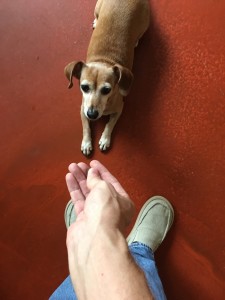Michael Baugh CDBC CPDT-KSA
Congratulations! You’ve completed a multi-visit training regimen with your dog trainer or dog behavior consultant. You’ve made excellent progress with your dog. The behavior you wanted to modify is under much better control. Maybe it’s even “fixed.” Kick back and relax. You’re done now. Right?
Um, no.
But, don’t worry. The hardest part is over. Behavior change is difficult. Maintaining your dog’s improved behavior is a bit easier. It still takes attention and work, though. Here’s how it looks. All this should be very familiar to you.
 Manage your dog’s behavior. Always set your dog up to succeed. Be aware of his surroundings. Watch to make sure we aren’t loading up too many stressors for him to handle all at once. Give him quiet time in his crate or in a safe place behind a baby gate. Use his muzzle and leash as needed. Maintain distance from triggering events when necessary. Protect your dog from making a mistake.
Manage your dog’s behavior. Always set your dog up to succeed. Be aware of his surroundings. Watch to make sure we aren’t loading up too many stressors for him to handle all at once. Give him quiet time in his crate or in a safe place behind a baby gate. Use his muzzle and leash as needed. Maintain distance from triggering events when necessary. Protect your dog from making a mistake.
Stick to the plan. Over the past weeks or months you’ve learned an excellent plan for helping your dog. You’ve taught him new ways to behave. You’ve taught him that he is safe in various situations that used to upset him. Stick to your plan. Your dog is relying on the predictable patterns you’ve set up. Varying from the routines you’ve taught him can be confusing. At worst, they can trip him up altogether and cause a regression. Stay consistent.
Reinforce good behavior. This is always a good idea. Keep noticing all the times your dog does something right. Support his good choices. Praise him. Give him treats. Play with him. Do this for the rest of your lives together. Really, keep doing this forever.
Help your dog navigate change. Behavior is always changing. Our world is always changing, too. Over the course of your dog’s life there may be a lot of changes. You may move to a new home. You may meet a new soulmate. Your work schedule may change. You may meet new friends and have them over to the house. With each change, help your dog by reviewing and adjusting his training routines. Teach him the skills to navigate these new experiences. In many cases you’ll be reinforcing old skills. This is a good way to remind your dog that he’s safe and that you’re there to help.
Flag trouble early. If you see a recurrence of your dog’s old unwanted behavior patterns, call in help. Don’t wait for it to occur several times. Call your trainer or behavior consultant right away. It doesn’t mean your efforts failed. It doesn’t mean your dog is doomed. He’s simply communicating the best way he can, with is actions. Most of the time, with some help, you can get things back on track.
Here’s a quick review:
- Manage behavior (you’ve been doing that all along)
- Stick to your training plan.
- Practice – Reinforce good behavior.
- Help your dog navigate changes in his environment.
- Flag trouble early. Call in help as soon as you notice any unwanted behavior.
You’ve come a long way already. You’ve learned so much and so has your dog. I suspect you two are closer to each other than ever now. That’s how it’s supposed to work. Better communication. More trust. Happier times. And a lifelong commitment to keep learning together.
Michael Baugh teaches dog training in Houston, TX. He specializes in dogs who are fearful and behave aggressively.

